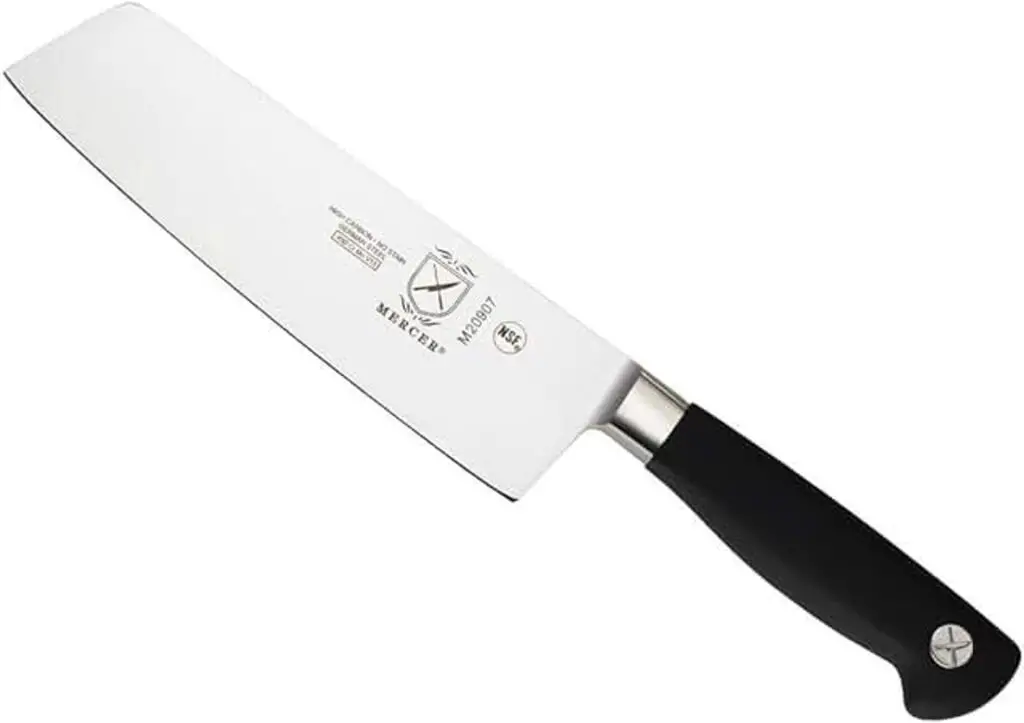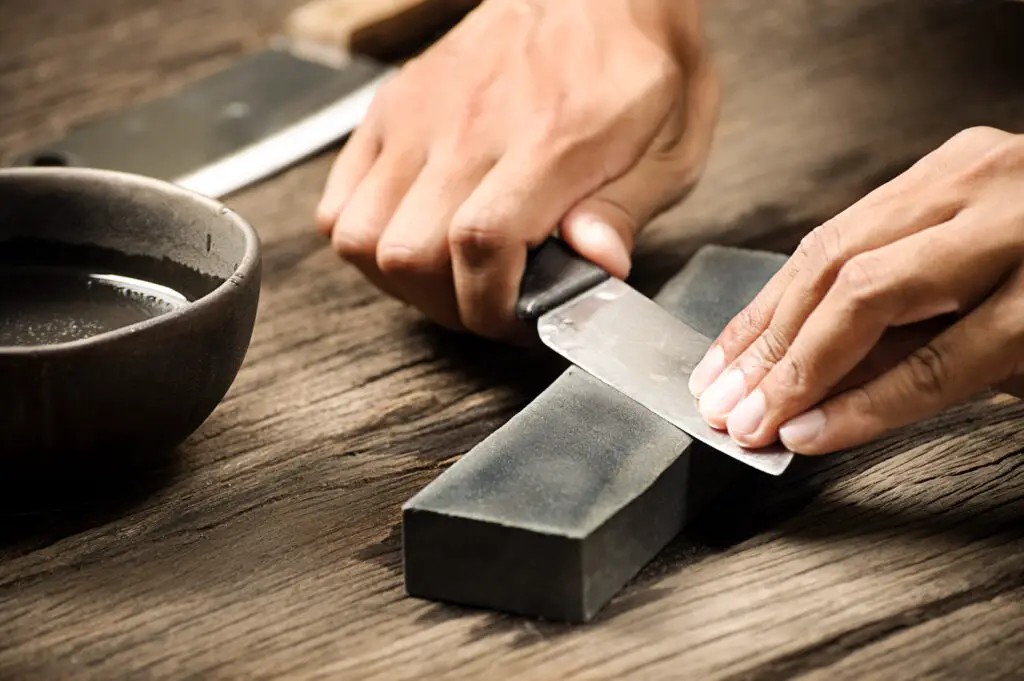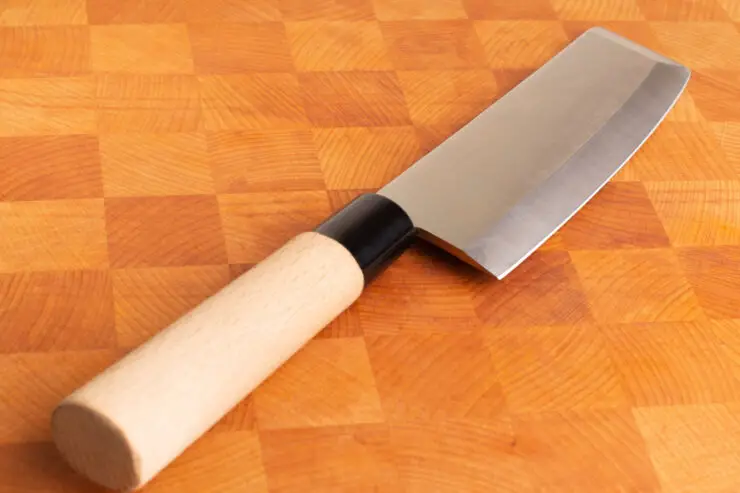As an Amazon Associate I earn from qualifying purchases. Please read the disclaimer for more info.
Are you on the hunt for the perfect Nakiri knife to elevate your culinary skills? Whether it’s for slicing, dicing, or chopping vegetables with precision, a quality Nakiri knife is a must-have in every kitchen arsenal.
This article will guide you through the top Nakiri knives in the market, taking into account their sharpness, durability, comfort, and overall performance. We’ll also dive into expert tips on how to choose the best Nakiri knife that suits your needs and budget.
So whether you’re a professional chef or a home cook looking to enhance your meal preparation, stay tuned as we cut through the options to help you find the ideal tool for your culinary adventures.
The Quick Answer
- Affordable Choice: Paudin Nakiri Knife – Best Seller!
- Mid-Range Option: GLOBAL 7″ Vegetable Knife
- High-End Pick: Sakai Takayuki Senkoku Damascus Nakiri Knife 6.5 inch
Related: Exploring Japanese Knives: Types, Benefits, and More
Key Takeaways
- Nakiri knives are essential for precise vegetable cutting with thin blades, rectangular shape, and balance point.
- Consider handle type, weight & balance, blade material, and cost when selecting the best Nakiri knife for you.
- Regularly clean and store your knife to ensure longevity while mastering proper safety techniques to enjoy efficient vegetable preparation.
Understanding Nakiri Knives
Nakiri knives are the secret weapon of many professional chefs and home cooks alike when it comes to cutting vegetables with precision and ease. With their straight cutting edge and thin blade, these knives are perfect for push-chopping vegetables like:
- peppers
- cabbage
- potatoes
- onions
- fruits
Unlike a Western-style chef’s knife, the entire flat edge of a Nakiri knife comes into contact with the cutting board at once, making it ideal for push-chopping rather than the rocking and slicing motion used with a chef’s knife.
The right Nakiri knife has a rectangular blade that resembles a small Chinese cleaver, but don’t be fooled – this lightweight knife is specifically designed for cutting vegetables, not very hard materials like dense winter squash or animal bones. Most Nakiri knives are blade-heavy, offering a balance point along Nakiri’s blade that makes them comfortable and easy to use.
Blade Design
The key to a Nakiri knife’s superb vegetable-cutting ability lies in its blade. These knives feature:
- A thin, straight, and double-bevel-edged knife, also known as a double-beveled knife that allows for precise and efficient slicing and dicing
- The ideal blade length ranging from 6.5 to 8 inches, providing superior control and allowing for faster and more accurate chopping
- The blade’s spine should be one to two millimeters wide at its thickest point, ensuring the entire flat edge remains sharp and effective.
Beyond its impressive performance, the Nakiri blade impresses with its unique aesthetics, frequently crafted from premium materials such as stainless steel, carbon steel, or Damascus steel. The thinness and sharpness of the blade contribute to the Nakiri knife’s exceptional cutting ability, making it a valuable addition to any kitchen.
Handle Types
Nakiri knives have various handle designs, including traditional Japanese and Western-style handles. The handle’s shape, material texture, length, and weight balance all make a lightweight knife comfortable to hold. Finished pakkawood composite handles are often seen on Nakiri knives, offering durability and a pleasing aesthetic.
The handle design plays a pivotal role in the comfort and grip of a Nakiri knife, thereby influencing the performance of its blade. Thus, selecting a Nakiri knife with a handle that provides a comfortable and secure grip is paramount.

Related: The Top Kitchen Knives of 2024: Expert Reviewed and Tested
Selecting Your Ideal Nakiri Knife
With a clear understanding of Nakiri knives and their unique features, we can now assess the factors that will guide you to the ideal knife for your culinary needs. Important aspects to evaluate include:
- Handle shape and texture
- Weight
- Blade length
- Overall feel of the knife
Remember that the ideal Nakiri knife should provide a comfortable grip, be lightweight for easy maneuvering, and have a sharp, thin blade for precise and efficient vegetable cutting.
Cost is another vital aspect that should be considered when choosing your perfect Nakiri knife. With a starting price of approximately $60 for a quality Nakiri knife, options are available for various budgets and preferences. Finding a balance between price and quality when selecting a Nakiri knife is crucial to ensure you get the best value for your investment.
Next, let’s explore our top picks for Nakiri knives, including affordable, mid-range, and high-end options.
Weight and Balance
A well-balanced and lightweight Nakiri knife is crucial for better control and precision during use. The ideal weight for a Nakiri knife can vary depending on personal preferences, but it should feel comfortable and manageable in your hand.
Our tests revealed that some of the best Nakiri knives, in terms of balance, had their lines approximately 0.25-0.5 inches ahead of the bolster (the junction of the blade and handle). Finding the perfect weight and balance for your Nakiri knife will ensure a more enjoyable and efficient vegetable-cutting experience.
Blade Material
Regarding blade material, Nakiri knives are available in high-carbon steel and stainless steel. High-carbon steel blades offer better sharpness and edge retention, making them popular among professional chefs and experienced home cooks.
On the other hand, stainless steel blades are easier to maintain but may dull faster. It’s essential to consider the pros and cons of each blade material and choose the one that best suits your needs and cooking style.
Price Considerations
Nakiri knives are available at various prices, from affordable options perfect for beginner cooks to high-end models designed for culinary enthusiasts and professionals. When selecting the perfect Nakiri knife, it’s essential to balance price with quality and consider factors such as blade material, handle design, and overall performance.
In the following section, we’ll introduce our top Nakiri knife picks for 2023, covering affordable, mid-range, and high-end options, each offering unique features and benefits to suit your preferences and budget.
Related: The Best Japanese Knife Set of 2024: A Guide to Choosing the Right Set
Top Nakiri Knives for 2024
Without any delay, here are our top Nakiri knife recommendations for 2024. We’ve carefully selected these knives based on their performance, design, and value for money.
Whether you’re on a budget or looking to invest in a premium option, there’s a Nakiri knife on this list that will cater to your needs and help you master the art of vegetable cutting.

Affordable Choice: Paudin Nakiri Knife
The PAUDIN Nakiri Knife is a versatile tool that seamlessly combines the functionality of a meat cleaver and a vegetable knife. With its 7-inch razor-sharp blade, this multipurpose Asian chef knife makes quick work of any chopping task in your kitchen.
Constructed from high carbon stainless steel, the PAUDIN Nakiri Knife delivers exceptional durability and resistance to rust and corrosion. This high-quality material also contributes to the knife’s superior sharpness, making it easy to achieve precise cuts every time.
One of the standout features of this knife is its ergonomic handle. Designed with comfort and efficiency in mind, the handle ensures a secure grip, reducing hand fatigue during prolonged use.
Whether you’re a professional chef or a home cook, the PAUDIN Nakiri Knife offers the perfect balance of performance, comfort, and style. It’s an excellent addition to any kitchen, suitable for a wide range of tasks from slicing meat to chopping vegetables.
Mid-Range Option: GLOBAL 7″ Vegetable Knife
If you’re looking for something in the mid-range price bracket, the GLOBAL 7” Vegetable Knife is a fantastic option. This Nakiri knife offers a durable and sharp edge, making it perfect for slicing and dicing various vegetables.
However, its handle may not be as comfortable as other options, which could be a drawback for some users. Nevertheless, the GLOBAL 7” Vegetable Knife is an excellent choice for those seeking a quality Nakiri knife at a reasonable price.
High-End Pick: Sakai Takayuki Senkoku Damascus Nakiri Knife 6.5 inch
The Sakai Takayuki Senkoku Damascus Nakiri Knife is a highly favored brand among Japanese chefs. This Nakiri knife, specifically designed for vegetable cutting, features a blade length of 6.5 inches, offering ample surface area for slicing and dicing your favorite veggies.
What sets this knife apart is its construction. The blade is made of VG-10 Stain Resistant Steel at the core, which is then enveloped in layers of Damascus steel. This not only provides the knife with a strikingly beautiful pattern on the blade but also enhances its durability and sharpness.
Moreover, the Sakai Takayuki Senkoku Damascus Nakiri Knife is known for its double bevel edge type and a comfortable handle length of 133mm, making it a great choice for both professional cooks and home chefs alike.
If you’re looking for a reliable, high-quality Nakiri knife that delivers excellent performance and longevity, the Sakai Takayuki Senkoku Damascus Nakiri Knife is definitely worth considering
Caring for Your Nakiri Knife
Appropriate care is key to maintaining the lifespan and performance of your Nakiri knife. From sharpening techniques to cleaning and storage, taking good care of your Nakiri knife will not only keep it in top condition but also make your vegetable-cutting tasks more enjoyable and efficient.
In this section, we’ll share some essential tips on how to care for your Nakiri knife so it remains a valuable addition to your kitchen for years to come.
Sharpening Techniques
Maintaining the sharpness of your Nakiri knife is vital for meticulously and efficiently cutting vegetables. A whetstone is one of the best ways to sharpen your Nakiri knife at home. Here’s how:
- Start by soaking the stone in water for 10-15 minutes, then place it on a flat surface.
- Hold the Nakiri knife at a 20-degree angle against the stone and move it circularly while applying light pressure.
- Repeat this process until the blade is sharp.
Alternatively, you can hone your Nakiri knife with a ceramic honing rod, using a similar technique and ensuring the rounded tip remains sharp.
Always wear protective gloves and eye protection when sharpening your Nakiri knife to ensure safety.

Cleaning and Storage
After each use, make sure to clean your Nakiri knife to uphold its quality and avert any potential damage. Wash the knife with warm, soapy water and a soft sponge, avoiding automatic dishwashers. Dry the knife thoroughly before storage to prevent rust or staining.
For storage, consider wiping the blade with vegetable oil or camellia oil to protect it from rust, then wrap the knife in newspaper and store it securely. Following these simple cleaning and storage tips will help ensure your Nakiri knife remains in optimal condition for years to come.
Mastering the Art of Nakiri Knife Usage
Now that you know about selecting, caring for, and maintaining your Nakiri knife, the next step is to master its usage. You’ll become an expert at efficient and safe vegetable preparation with your Nakiri knife by practicing proper chopping techniques and following safety tips.
This section will share essential tips and techniques to help you make the most of your Nakiri knife and elevate your culinary skills to new heights.
Chopping Techniques
When using your Nakiri knife, follow these steps for precise and efficient vegetable cutting:
- Employ a push-chopping motion.
- Lift the knife completely between slices.
- Hold the knife with a pinch grip, positioning your thumb and forefinger on the blade while the other three fingers provide guidance.
This technique will give you better control and accuracy when slicing produce with your Nakiri knife. Practice these chopping techniques, and you’ll soon be slicing and dicing vegetables like a pro.
Safety Tips
Ensuring safety should be of utmost importance while using your Nakiri knife. Keep your fingers curled away from the blade and use a stable cutting surface, such as a cutting board, to protect your countertop and prevent accidents.
Ensure your knife is sharp, as a dull blade can cause slipping and increase the risk of injury. By following these safety tips and practicing proper knife handling techniques, you can enjoy efficient and safe vegetable preparation with your Nakiri knife.
Summary
In conclusion, a Nakiri knife is essential for any kitchen enthusiast looking to enhance their vegetable cutting skills. By understanding the unique design of Nakiri knives, selecting the right one based on factors such as weight, balance, blade material, and price, and mastering the art of using and caring for your Nakiri knife, you’ll transform your culinary experience and make every slice feel like a breeze. So, why wait? Discover the perfect Nakiri knife for 2023 and elevate your kitchen game today!
If you found this article useful, you might enjoy one of these:
- The Art of the Japanese Sword
- Are Dalstrong Knives Worth It? A Comprehensive Review
- Finding the Perfect Japanese Pocket Knife for Every Occasion
- Best Japanese Chopsticks for Home Use
- 13 Best Japanese Cookbooks to Master Japanese Cuisine
- 9 Best Sushi Cookbooks to Master the Art of Sushi
Frequently Asked Questions
What is a nakiri knife used for?
A Japanese Nakiri knife is designed for slicing, dicing, and chopping vegetables. It features a flat, straight-edge blade with a longer blade length than other prep knives and is double-beveled for added safety.
Can you use a Nakiri on meat?
While the nakiri can be used for boneless cuts of meat and fish, it is better suited for chopping and dicing vegetables.
What wouldn’t you use a Nakiri or santoku for?
The Nakiri is specifically designed for cutting vegetables, making it the perfect tool for vegetarians and vegans; however, it should not be used for slicing meat or splitting bones.
What makes Nakiri knives unique?
Nakiri knives have a distinctive double-beveled blade and comfortable handle, making them ideal for precise vegetable cutting. They are a popular choice for professional chefs and home cooks alike.
How do I choose the right Nakiri knife?
When selecting a Nakiri knife, make sure to consider its weight, balance, blade material, handle design, and price to ensure you pick the best one for your needs.

